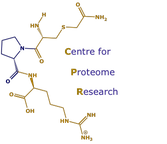Marvellous molecules at the VG&M!
VG&M ‘Marvellous Molecules’ Summer Science Club
Rosie Maher
On Tuesday 28th August, six members from the Centre for Proteome Research in IIB held a VG&M summer science club session for local primary school children. The session, entitled ‘marvellous molecules’, began with a messy activity where the children were able to explore the components of “blood”. We used water beads, ping pong balls and square pieces of sponge to represent the red blood cells, white blood cells and platelets, respectively. The three components were bathed in water to represent blood plasma. All four components were correctly identified by the children and they even knew all the functions! 
The 'pretend blood' exercise!
We then went on to explain that blood cells contain DNA sequences and that these sequences can be used to make proteins in our body. The children each selected a blood cell from the “blood” mixture and opened them to reveal a laminated DNA sequence that coded for a different protein from different organisms. For example we had the DNA code for a protein in the venom of a cobra and the protein that causes oranges to ripen. Using this code the children could create DNA code bracelets where each nucleobase corresponded with a particular colour of bead. After creating the parent strand, using base coding pairs, the children were able to create the daughter strand. The children enjoyed this so much some made up to 3 bracelets!

Making DNA bracelets
Next we moved onto ‘DNA whispers’. This was a 'Chinese whispers' activity using sentences about DNA to explain how it can sometimes be copied incorrectly causing errors. Some changes often don’t cause a problem, however, other errors (or mutations) can cause genetic diseases such as sickle cell anaemia. One of the sentences used in the game was “Even identical twins don’t have identical DNA” which got changed to “Even identical twins don’t have DNA”, proving a point about how small changes can have a big effect on the meaning of the sentence, or in terms of proteins, their function. We explained about sickle cell anaemia and the children were able to mix some blue water beads into the “blood” mixture, representing the less oxygenated sickle cells. We explained that people with sickle cell anaemia can experience pain, but using some ‘marvellous molecules’ we can treat these symptoms. We looked at the structure of three of these molecules; paracetamol, ibuprofen and aspirin and got the children to make the structures out of paper and pipe cleaners.

Molecular modelling!
We finished the session by asking the children questions about what they had learnt during the session. They were able to answer every question and were awarded with stickers for the correct answers.
We were all very impressed by the knowledge and enthusiasm of the children that attended the session and we look forward to helping out again next year!
